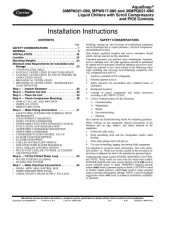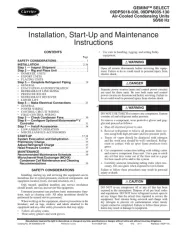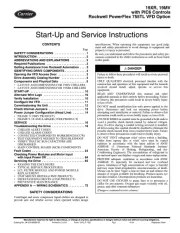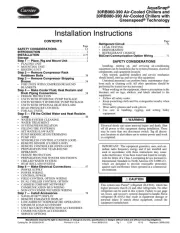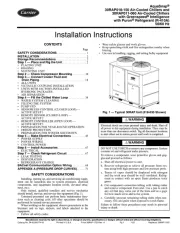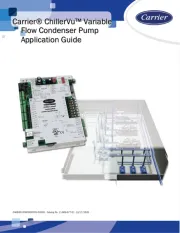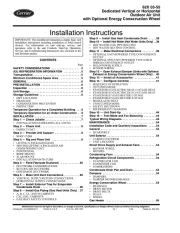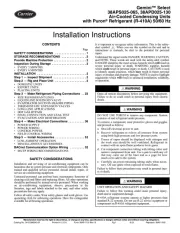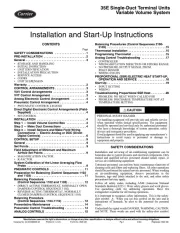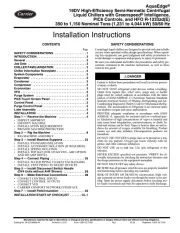
Manufacturer reserves the right to discontinue, or change at any time, specifications or designs without notice and without incurring obligations.
Catalog No. 04-53300174-01 Printed in U.S.A. Form 30RAP-17SI Rev. A Pg 1 1-22 Replaces: 30RAP-16SI
Installation Instructions
CONTENTS
Page
SAFETY CONSIDERATIONS. . . . . . . . . . . . . . . . . . . . . . 1
INSTALLATION . . . . . . . . . . . . . . . . . . . . . . . . . . . . . . . . . . 2
Storage Recommendations . . . . . . . . . . . . . . . . . . . . . . 2
Step 1 — Place and Rig the Unit. . . . . . . . . . . . . . . . . . 2
•PLACING UNIT
•RIGGING
• MOUNTING UNIT
Step 2 — Check Compressor Mounting . . . . . . . . . 18
Step 3 — Connect Cooler Fluid and
Drain Piping. . . . . . . . . . . . . . . . . . . . . . . . . . . . . . . . . . 18
•ALL UNITS
• VICTAULIC COUPLING INSTALLATION
• UNITS WITH FACTORY-INSTALLED
HYDRONIC PACKAGES
•AIR SEPARATION
Step 4 — Fill the Chilled Water Loop . . . . . . . . . . . . 34
• WATER SYSTEM CLEANING
• FILLING THE SYSTEM
•PUMP VFD
• SENSORLESS CONTROL (CLOSED LOOP) —
ACTIVE SETUP 1
• REMOTE SENSOR (CLOSED LOOP) —
ACTIVE SETUP 2
• REMOTE CONTROLLER (OPEN LOOP) —
ACTIVE SETUP 3
• PREPARATION FOR YEAR-ROUND OPERATION
• FREEZE PROTECTION
• PREPARATION FOR WINTER SHUTDOWN
Step 5 — Make Electrical Connections . . . . . . . . . . 45
• POWER SUPPLY
•POWER WIRING
• CONTROL POWER
Step 6 — Install Accessories . . . . . . . . . . . . . . . . . . . . 67
• ELECTRICAL
Step 7 — Check Refrigerant Circuit . . . . . . . . . . . . . 67
• LEAK TESTING
• DEHYDRATION
• REFRIGERANT CHARGE
BACnet Communication Option Wiring . . . . . . . . . 68
APPENDIX A (PRESSURE DROP CURVES). . . . . . 71
SAFETY CONSIDERATIONS
Installing, starting up, and servicing air-conditioning equip-
ment can be hazardous due to system pressures, electrical
components, and equipment location (roofs, elevated struc-
tures, etc.).
Only trained, qualified installers and service mechanics
should install, start up, and service this equipment (Fig. 1).
Untrained personnel can perform basic maintenance func-
tions such as cleaning coils. All other operations should be
performed by trained service personnel.
When working on the equipment, observe precautions in the
literature and on tags, stickers, and labels attached to the
equipment.
• Follow all safety codes.
• Wear safety glasses and work gloves.
• Keep quenching cloth and fire extinguisher nearby when
brazing.
• Use care in handling, rigging, and setting bulky equipment.
WARNING
Electrical shock can cause personal injury and death. Shut off
all power to this equipment during installation. There may be
more than one disconnect switch. Tag all disconnect locations
to alert others not to restore power until work is completed.
WARNING
DO NOT USE TORCH to remove any component. System
contains oil and refrigerant under pressure.
To remove a component, wear protective gloves and gog-
gles and proceed as follows:
a. Shut off electrical power to unit.
b. Recover refrigerant to relieve all pressure from sys-
tem using both high-pressure and low pressure ports.
c. Traces of vapor should be displaced with nitrogen
and the work area should be well ventilated. Refrig-
erant in contact with an open flame produces toxic
gases.
d. Cut component connection tubing with tubing cutter
and remove component from unit. Use a pan to catch
any oil that may come out of the lines and as a gage
for how much oil to add to the system.
e. Carefully unsweat remaining tubing stubs when nec-
essary. Oil can ignite when exposed to torch flame.
Failure to follow these procedures may result in personal
injury or death.
Fig. 1 — Typical 30RAP Unit (018-030 Shown)
AquaSnap
®
30RAP018-150 Air-Cooled Chillers and
30RAP011-060 Air-Cooled Chillers
with Greenspeed
®
Intelligence
with Puron
®
Refrigerant (R-410A)
50/60 Hz

